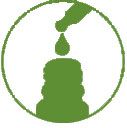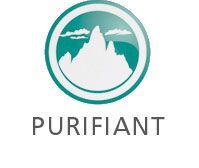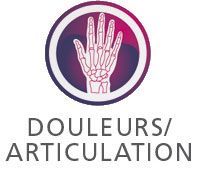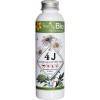How to use an essential oil ?
Use : the 3 main principles
 Essential oils There are a thousand and one ways to use an essential oil. You'll benefit from its therapeutic qualities combined with fresh, enchanting or deep fragrances.... your imagination will do the rest !
Essential oils There are a thousand and one ways to use an essential oil. You'll benefit from its therapeutic qualities combined with fresh, enchanting or deep fragrances.... your imagination will do the rest !
Examples of uses:
- Pure (linens, diffusers)
- Diluted in alcohol, vinegar, liquid soap, etc.
- Added to vegetable oils to create your own massage oil
Different ways of using them
Essential oils are primarily used externally. For internal use, the advice of a qualified aromatherapist is recommended, for reasons of dosage and the potential toxicity of certain oils.
Here are the 6 main ways in which essential oils can be used :
 Oral use
Oral use
Must be diluted on a carrier. Advice must be sought from a health professional.
Some essential oils can be used internally, for example: to aid digestion (Roman chamomile, basil, orange), to stimulate the body's defences (tea tree, ravinstara, eucalyptus radiata). They should never be taken undiluted or applied directly to the tongue. To dilute and incorporate essential oils evenly, mix them well with vegetable oils, honey, yoghurt or neutral tablets. They can also be used in your cooking (for AB-certified essential oils). 1 to 2 drops are all you need to give your dishes an original, long-lasting fragrance. Be sure to follow the precautions for use given on the essential oils' technical data sheets.
 Massage
Massage
Use pure or diluted, depending on the oil. Essential oils have a remarkable ability to penetrate the skin. They must be diluted in a vegetable oil before use. Depending on skin tolerance, dilution can vary greatly from one essential oil to another.
Average dosage : 10 to 50 drops of essential oil(s) in 100 ml of vegetable oil.
Exception: certain oils such as lavender, geranium and tea tree can be applied directly to the skin.
Local application or rubbing : Essential oils can be applied locally, by gentle massage or rubbing: ideal for relieving muscles after exercise, eliminating orange peel skin, restoring elasticity and suppleness to the skin...
Essential oils can also be used as cosmetic active ingredients. They can be added to some of your 'homemade' cosmetics. Add cold, at the end of preparation, up to 2% for a "face" treatment or 5% for a "body" treatment.
 In the bath
In the bath
15 to 20 drops of essential oil(s) added to the bath water (180 litres) is one way of combining the useful with the pleasurable. Caution: never add pure essential oils to the bath: dilute them in a tablespoon of milk or other dispersant (e.g. coarse salt, vinegar, honey, egg yolk --> see our paragraph at the bottom of the file). Do not use peppermint essential oil in the bath: risk of thermal shock.
 Atmospheric diffusion
Atmospheric diffusion
Diffusing essential oils is undoubtedly one of the best ways to purify the atmosphere at home or at work. Using a suitable diffuser or mister, you can vaporise the essential oil or blend of essential oils without any thermal effect and therefore without any risk of altering the active ingredients of the essential oil.
Other tips : a few drops on a handkerchief, a few drops on a pad inserted in the car's ventilation system...
About an hour's diffusion a day can rid rooms and working environments of unpleasant odours and infectious germs. It's also a natural way of repelling insects in summer and pleasantly perfuming the atmosphere.
 Inhalation
Inhalation
A few drops of essential oils in a bowl of hot water are enough to obtain the desired effect, as they diffuse locally. 2 to 3 drops of eucalyptus, Scots pine, tea tree or thyme essential oils to clear the respiratory tract. To tone and cleanse the skin, use hyssop, geranium, etc. in a facial sauna.
Use on a compress
Using essential oils in compresses gives good results when applied locally. To soothe, calm inflammation and heal small wounds, superficial cuts and light burns. Dilute a few drops of essential oil in a vegetable oil, then apply the mixture to a warm, moistened compress.
Certified organic pure and natural essential oils
Be careful when buying essential oils. Some unscrupulous retailers offer plant essences, concentrates and natural perfumes. The only real guarantee that an essential oil is genuine, pure, natural and certified organic is its certification. All the essential oils sold on our site carry either the AB label or a certified organic origin.
Massage : good for the body
Massage is the quickest way to enjoy the benefits of an essential oil. Use it mixed with vegetable oil such as sweet almond. Some oils can be applied pure to the skin, but most must be diluted. Observe the precautions for use indicated for each essential oil, such as basil (max 0.5%). A skin test, in the crease of the elbow, can be carried out to check your own sensitivity to a given essential oil.
To create your own massage oil, unless contraindicated, the recommended concentration of essential oils is :
- Facial oil : 1 to 2% (20 to 40 drops for 10 cl)
- Body massage oil : 2 to 5% (40 to 100 drops for 10 cl)
- Skin care oil : 5 to 8% (1 to 1.5 teaspoons per 10 cl)
Using of a massage oil :
It is important to massage in the essences thoroughly. In this way, the aromatic principles will produce their full effect.
- On the solar plexus, to vitalise and regenerate your strength.
- Along the spine, on the soles of the feet or on the wrists for relaxation.
- The stomach and belly for all those little problems of bloating and flatulence.
- In the lower back for aphrodisiac massages...
But essential oils can also be used for :
- Respiratory tract inhalation : a few drops of oil (2 for mint) in a bowl of water at 45° while breathing deeply.
- Gargling : 1 to 2 drops in a glass of boiled water (do not swallow).
- Skin care : add a few drops of oil (2%) to your skin care cream.
- Hair care : add 20 drops of essential oil to a glass of shampoo.
- In the shower : apply 3 to 4 drops to a damp glove and rub over your body.
Change the atmosphere in each room
Personalise your home and create a journey dedicated to awakening all your senses. It's so easy, all you need to do is :
- A few drops of essential oil to revive the aroma of potpourri or dried flowers. Spread oil-soaked cotton wools around the room.
- Air freshener : Dilute 1 to 2% of essential oils in alcohol (vodka would be very effective, but 90° alcohol will also do!). You can add distilled water in any proportion you like. The more water you add, the faster the mixture sinks and the wetter it becomes. Do not exceed 10% water. In our air fresheners, it should be around 5%.
- Diffuse essential oils using special aromatherapy diffusers. This regular practice rids the air of pathogenic germs and prevents microbial illnesses by boosting the immune system.
- Diffuse oils using a perfume burner : Put a little water in the dish of the perfume burner, light the candle underneath, and pour a few drops of essential oil into the water. As the water heats up, the oil floats to the surface and evaporates into the air, banishing unpleasant odours and creating a feeling of comfort and well-being.
- Diffuse oils using an indoor diffuser (sponge) : Protected in its jar, it can be placed anywhere (home, office, car, etc.). Simply open it to breathe and enjoy the benefits of essential oils at any time.
- Diffuse oils using a light bulb ring : placed on an electric light bulb or suspended, the terracotta ring soaks up essential oil and releases it when the bulb heats up. Very fast-acting but brief, it immediately eliminates unpleasant odours Simply pour a few drops of essential oil onto the light bulb whenever you feel like it and switch on the light.
- Diffuse essential oils in your car using our special car diffusers. The arôma Car (plugged into the cigarette lighter) or the ceramic diffuser that you attach to the ventilation grille.
How do you choose your essential oils ?
Personalise your home and make a journey dedicated to awakening all your senses. It's as simple as that :
A few drops of essential oil to revive the aroma of potpourri or dried flowers. Spread oil-soaked cotton wools around the room.
Micro-diffusion (also known as nebulisation)
Micro-diffusion is still the most effective method of diffusing essential oils (no change to the chemical structure). Compressed air transforms the essential oils into millions of ionised micro-particles that fill the room in a few seconds. Not just the aroma, but the entire oil is diffused in a very fine mist that resembles an aerosol. It is only by using this method that all the properties of the essential oils are released into the air. Discover all our models of microdiffusion diffusers.
Some ideas for blends
- Calm and restful for your children's bedroom : mandarin combined with lavender.
- Clean and fresh for your kitchen : lemon and bergamot.
- A warm ambience for your living room : a blend of lavender and orange.
- For your bedroom, opt for an exotic and promising blend : ylang-ylang and bergamot...
- To keep flies and mosquitoes away : eucalyptus and lemongrass
Personalise your everyday life with essential oils
A few drops of essential oil
- On your clothes and household linens, in your toilet bag, your shoes and your mail
- On cotton wool in your car glove compartment
- On a cloth that you put in your tumble dryer
- Added to your washing machine softener
The aromatic bath
A bath (whole body, feet, hands, etc.) with essential oils will bring you well-being and relaxation. Their primary virtues are to relax and eliminate the stresses that often block the body's vital functions. But be careful : most essential oils are not naturally water-soluble, so they are difficult to incorporate into bath water. Don't use surface-active products (such as liquid soap), which solubilise the lipids contained in essential oils, making them water-soluble.
These foaming baths act as detergents and attack the epidermis, stripping it of its protective film and chemically destroying the original composition of the essential oil and altering its active ingredients.
Several solutions are available to make it easier to dilute essential oils in water, without altering their properties. Whichever method you use, allow about ten drops of essential oil to be mixed with the product and then poured into the bath water.
- Dispersants or neutral bases can be used to incorporate 5-10% essential oils :
- Coarse salt : pour the essential oils onto 50g of salt.
- Cider vinegar : dilute the essential oils in a cup of vinegar.
- Milk : dilute the essential oils in 1/4 litre of milk
- Egg yolk : dilute the essential oils in the egg yolk (exclude the white).
Choose your essential oil :
- Cellulite : Grapefruit, Cypress, Lemon, Rosemary
- Circulation : Cypress, Lemon
- Insomnia : Lavender, Orange, Mandarin, Ylang-Ylang
- Stress : Cedarwood, Pine, Ylang-Ylang
Essential oils and children
Essential oils are very powerful. They should be used in moderation and in compliance with the precautions for use relating to each of them. It is forbidden to use essential oils on children under the age of 3. Some manufacturers even indicate up to 7 years. From the age of 3, divide all doses by two or three to be on the safe side. As a precaution, use gentle essential oils such as citrus or diffuser synergies specially designed for children. (example: our Children's dreams synergy).
Essential oils for winter
Winter is coming, and with it its colds, coughs, sinusitis, etc. Essential oils can help you to combat all those little "aches and pains" that are often not very serious, but really annoying. You can use these oils for diffusion, inhalation and massage. For greater effectiveness, don't hesitate to mix them together. Beware of overdosing: an inhalation with more than 10 drops becomes very difficult to breathe, especially with eucalyptus! A mixture that we find particularly effective as an inhalation, for all problems with blocked noses, colds, etc., is a mixture of Eucalyptus + Scots pine + Tea tree (you can use eucalyptus globulus or radiata, which is milder).
- Antibacterial : Basil, Lemon, Eucalyptus, Lavender Aspic, Peppermint, Niaouli, Palmarosa, Scots Pine, Ravensare, Rosemary, Tea Tree.
- Cough suppressants : Cypress, eucalyptus.
- Antiviral : Lemon, Eucalyptus, Lavender Aspic, Peppermint, Niaouli, Palmarosa, Ravensare, Tea Tree.
- Expectorant : Eucalyptus, Lavender Aspic, Niaouli, Scots Pine, Ravensare, Rosemary.
- Mucolytics : Eucalyptus, Rosemary.
The 8 main categories of essential oils

To make it easier to identify the main family for which an essential oil can be used, Laboratoire Gravier, our main supplier, has designed small pictograms that can be found on each box depending on the intended use. Here they are :

- Bergamot (citrus bergamia)
- Roman Chamomile (Chamaemelum nobile)
- Lavender (lavandula angustifolia)
- Lavandin super (lavandula hybrida)
- Green mandarin (citrus reticulata)
- Sweet orange (citrus sinensis)
- Bitter Orange (citrus aurantium ss amara)

- Tropical basil (ocimum basilicum)
- Marjoram (origanum majorana)

- Altas cedar (cedrus atlantica)
- Lemon (citrus limon)
- Cypress (cupressus sempervirens)
- Italian helichrysum (helichrysum italicum)
- Grapefruit (citrus paradisi)

- Cinnamon (cinnamommum zeylanicum)
- Peppermint (mentha piperita)

- Clove (eugenia caryophyllus)
- Oregano (origanum compactum)
- Ravintsara (cinnamommum camphora)
- Tea tree (melaleuca alternifolia)
- Thyme with thymol (thymus vulgaris)

- Lemongrass (cymbopogon winterianus)
- Geranium (pelargonium asperum)
- Patchouli (pogostemon cablin)
- Clary sage (salvia sclarea)
- Ylang (cananga odorata)

- Eucalyptus citriodora (eucalyptus citriodora)
- Gaultherie wintergreen (gaultheria fragrantissima)
- Juniper (juniperus communis)

- Eucalyptus globulus (eucalyptus globulus)
- Eucalyptus radiata (eucalyptus radiata)
- Niaouli (lelaleuca viridiflora)
- Camphor rosemary (rosmarinus officinalis)
- Scots pine (pinus sylvestris)
Please note : the information contained on this page is for information purposes only. It has been taken from scientific works by recognised authors and does not under any circumstances constitute medical information or incur the liability of Penn'Ty Bio. For any use of essential oils for therapeutic purposes, please consult a specialist in essential oils.
Measurements and concentrations
- Essential oils are highly active concentrates. It is therefore important to respect the doses, down to the last drop. Moreover, beyond a certain quantity, there is a plateau effect and the effects no longer increase in proportion to the dose.
- 20 drops = about 1 ml
- 100 drops = about 5 ml or 1 teaspoon
- 1 tablespoon = about 20 ml
You can obtain a concentration of around 1% by putting :
- 1 drop in 1 teaspoon
- 4 drops in a tablespoon
- 20 drops in 10 cl








Customer reviews
Excellent site. Très à l'écoute. Livraison rapide. Problème avec un piège à guêpes un autre m'a été livré très rapidement. Chapeau et très agréable de tomber sur des gens compétents.<br /> Encore merci.
XX
Client depuis plus de 10ans. Toujours satisfait du matériel propose. Boutique sérieuse prix compétitifs livraisons et suivis rapide.
XX
Site très sérieux, de très bons produits et la livraison est rapide.<br />
Isabelle
Boutique très sérieuse avec un envoie rapide et des produits super efficaces.
XX
Entièrement satisfaite.
Ch. D.
interressante. Beaucoup d'articles référencés. Après pour la lutte contre les punaises de lit, je ne suis pas sure de l'efficacité de certains produits. C'est un vrai fléau ces bestioles.
Francelyne D.
Beaucoup de soins dans la commande reçue. Je recommande!
XX
Prix intéressants. Expédition super rapide à bon prix. Et tout ça de façon agréable !
Alexis M.
J'ai reçu le colis, merci beaucoup de votre promptitude et bonne continuation.
Louise
Merci pour votre efficacité et votre gentillesse, commande, livraison, petit mot agréable, tout était parfait !
Sylvie
Je voulais juste vous remercier. J ai reçu mon répulsif " lézards" aujourd'hui, un petit mot super gentil joint à ma commande ça fait plaisir. J espère que ça va fonctionner. Bonne journée à vous et merci.
Cynthia
Suite à un précédent message notifiant une erreur de produit à la livraison, Penn'Ty bio m'a fait parvenir à titre gracieux le bon produit. Merci
Martine
Ravie de découvrir un site qui présente des produits de qualité avec une vraie démarche éco responsable à des tarifs intéressants.
XX
Service très réactif, emballage soigné , livraison rapide. <br /> Rien à redire . Continuez !!
Sophie
Livraison très rapide. Bravo pour la réactivité
François
Bon rapport qualité-prix. Envoi rapide et sécurisé !
Chrile
Livraison rapide et petit mot manuscrit joint au colis, vraiment très sympa! Merci et continuez, vous le méritez.
Jean-Pierre
Bon produit. Merci Penn'Ty Bio. Un seul passage dilué à 5% et les puces ont disparus. Il en restait deux ou trois qui ont dû se perchés pendant le traitement mais sinon c'est performant.
Axel
Je confirme efficacité sur la préparation et expédition du matériel. un grand merci
Jeremy
Merci beaucoup pour la rapidité avec laquelle vous m'avez fait parvenir le diffuseur.
Bichette
Commande tout à fait conforme et emballée avec grand soin.
Sarah
Site clair, envoi rapide, marchandises bien emballées, et un petit mot charmant!
SM
Après essais de divers produits, votre insecticide 4J est le seul à être venu à bout des puces ramenées par le chat de la maison. Livraison rapide par chronopost
JEAN MARIE
Bon service et bon produits
Odile R
Pas encore essayé le produit, mais le site est très sérieux. Livraison dans un temps éclair, même si je suis en Belgique. Emballage soigné. On peut faire confiance.
Roberta
C’est la première fois que je commande sur ce site et pas déçue livraison rapide de ce produit que l’on ne trouve pas partout. Je recommande
Patrick
Nous sommes très satisfaits du service client : mot personnalisé dans le colis, disponibilité du service après-vente... Nous souhaitons à votre société un succès croissant.
Sara
J'ai toujours été satisfaite de mes commandes chez Penn'ty bio. Rapide efficace. Surtout les caractéristiques des produits est claire et complète. et le site contient beaucoup d'informations sur les différentes gammes. Merci pour votre travail et votre activité.
XX
Modèle conforme bien emballé délai respecter continuer comme ça parfait.
Carlos
Livraison rapide , le tout correspond à mes attentes.
Julie
Merci pour votre geste que j’apprécie.<br /> Cela fait plaisir de retrouver l’esprit commerçant de proximité chez un vendeur en ligne. Je surveillerai attentivement cette nouvelle livraison.
Philippe
Contente de voir que d’autres alternatives naturelles aux produits plus nocifs soient proposés. Entreprise sérieuse dont commandes sont très bien honorées. Merci.
Capzoe
Tout était parfait. Produit, prix, délai.
Marco
Merci pour votre envoi : rapidité, ponctualité, information de suivi du colis etc. Vraiment du bon boulot.
E.G
livraison impeccable, produit bien emballé et correspondant au descriptif, excepté pour la surface de diffusion, ma salle principale doit faire 25m2 maximum et ça ne se diffuse pas au-delà.
Pascale
Après un souci sur l’article livré, le site a fait preuve d’une excellente communication (simple et efficace par sms) qui m’a permis de me faire livrer un 2nd article par la marque très rapidement. Parfait !
Pierre
L’esprit commerçant de proximité chez un vendeur en ligne !
Philippe
MOI JE DIS INCROYABLE !!!<br /> Plus que mieux d'une rapidité de dingue ! bravo et le colis impeccable surprotégé.<br /> Que toutes les entreprises prennent exemple sur vous. merci
AURELIE A.
Fidèle à votre marque, je tenais par ce mail à vous féliciter vous et votre équipe pour votre longévité. Votre marque est toujours gage de qualité et sérieux.
Céline
Je suis cliente depuis de nombreuses années. Toujours satisfaite du site, des produits et de la livraison.
martine O.
Everything was very nice ! Keep handling your customers likes this!
xxx
Mon avis sur penntybio, très bon produit sur ce site pas une gamme monstrueuse mais que du très bon, et pareil pour les livraisons ultra rapides et le excellent sav si besoin. Je recommande vivement. Client depuis 2018 aucun soucis.<br /> <br />
thierry g.
Colis bien arrivé. Emballage remarquable. Diffuseur très joli, très efficace et peu bruyant avec de la couleur qui change. Très satisfaite de la commande.
Sabrina
Les produits sont de bonne qualité. Leur prix est raisonnable. Ils sont livrés rapidement, et en bon état.
XX
Colis très bien protégé service rapide. Merci. Site très sérieux .
Elios R.
colis dans les temps,emballage parfait,super accueil téléphonique pour renseignement, je recommande ce site.
ROSCO
J'ai bien reçu mes articles et je vous remercie pour la livraison rapide et impeccable !
Françoise
Livraison conforme et rapide. Les produits sont emballés dans des emballages recyclables, voire compostables : j'ai beaucoup apprécié. Je recommande ce site.
Patrick
accueil téléphonique personnalisé réactif compétent et bienveillant, livraison rapide et conforme. BRAVO merci pour la qualité de votre travail
Annick
Bien, la majeure partie des produits sont efficaces. Je connais cette boutique depuis plusieurs années, je recommande ce site.
XX
Avec les trois lettres BIO dans votre nom, je ne m'attendais pas à découvrir des billes de polystyrène comme matériaux de rembourrage. Il y a certainement plus écolo !
Michel D.
Commande reçu en 2 jours, impeccable. Tous les produits emballés avec le plus grand soin, petit mot personnalisé! Et encore un petit savon bio au parfum délicieux comme cadeau!! Merci Penn'Ty Bio !!
Orchidée
Livraison rapide. Produits bien emballés.
Bruno
Site de grande qualité !
Rose Anne Marie
Bons produits, emballage impeccable, livraison super rapide ! Parfait !
XX
J'ai bien reçu le colis sans aucun problème. Merci pour la rapidité et le sens du service.
Nicolas
merci de votre disponibilité et amabilité!
Eric
Merci pour tout le soin que vous mettez pour une livraison individualisée, chaleureuse et aussi peu impactante que possible sur l'environnement !
Sandra
Produits de bonne qualité, naturels et efficaces, expédition rapide et bien emballée, sav très rapide suite à une erreur de ma part,
XX
Tout est parfait de la commande à la réception. Commander jeudi et reçu samedi. Et très contente de mon achat . Je recommande
Nadege M.
Service rapide et efficace. Bons produits
XX
Très bon site. Envoi rapide. Prix moins cher que sur d autres sites. Bravo et bonne continuation.
Camille
Site de produits naturels et bio très bien fait, agréable et fiable. beaucoup de produits de qualité.
Anne Marie R.
Super produits, envoi rapide et soigné, conseils et échanges courtois ! Une jolie boutique en ligne pour acheter en toute confiance ! <br />
Patricia
Vos explications par email ont été très claires et votre diligence dans le traitement de ma commande et de mes demandes est très appréciée.
Henri
Merci et surtout, continuez, c'est rare de trouver sur internet une relation aussi personnalisée sur un mode aussi agréable.
Sabine
Rapidité de livraison. Très bon produits. Merci
Mélina
Explication, commentaire et livraison en un temps record, tout était parfait, même le petit mot de remerciement écrit à la main ! Merci beaucoup
Monique S.
La livraison est rapide, je n'ai jamais était déçue de ce site, et les produits sont pas chers et de très bonne qualité!
Patricia
Pour ma part j'ai été satisfaite de la réalisation de ma commande et du délai de livraison. Je recommande votre société.
Nelly
Produits d'excellente qualité, arrivés rapidement, et conformes à leurs descriptions.
Michelle G.
Parfait !
Mireille
très bien livraison dans les délais, colis intact, bon produit.
Martine
Site pratique, compétent, prix corrects. Un envoi très rapide, et je dirai "parfait".
Greg
Je tenais à vous remercier pour votre service de qualité, une livraison toujours rapide, des colis bien emballés - qui évitent fuites et casse, ainsi que pour le petit mot personnalisé joint à chaque commande, c'est toujours très agréable.
Isabelle G
Claudine
Personne disponible, de très bon conseil suite à des punaises de lits dans mon habitation, les produits sont efficaces car depuis aucune punaises et la vie à repris son cours ... merci pour tout
Nathalie
Bons produits. Fonctionnent très bien.
xx
Excellente communication, service très rapide (même à l'étranger), emballage parfait ...
Jacques N., Belgique
Bonjour, colis bien emballé arrivé sans encombre, démarche écolo bien ancrée et petit mot perso. Merci à l'équipe de Penn'Ty Bio.
Sofi
Commande reçue rapidement, frais de port raisonnables pour expédition à l'étranger et les produits sélectionnés au top! Merci!
Cédric Adolphe B.
Tout est parfait : la qualité des produits, la rapidité d'expédition, la qualité du colis. Je suis enchantée et resterai fidèle à ce site.
Dominique
Livraison rapide et avec colis préparé avec soin :)
Florian
J'ai été très déçue de ne plus trouver mon déboucheur dans mon biocoop habituel, et perplexe en apprenant qu'il était remplacé par un produit à base de soude...c'est comme ça que je vous ai trouvé sur internet.<br /> Alors merci pour le dépannage, pour le mot gentil qui accompagnait mon colis , et bravo pour le calage en amidon de maïs compostable!<br /> Bravo pour votre démarche et à très bientôt.
Cécile D.
colis reçu ce jour, merci pour le flacon offert
Andrée
clair net précis. merci
jannick
très bien je recommande.
Sylvie
Envoi très rapide, personnalisé et soigné. Merci
XX
Produit conforme aux attentes.<br /> <br /> <br /> <br />
Alain
Très bon site. Navigation facile. Les commandes sont expédiées rapidement comme annoncé. Aucun problème depuis que je suis cliente. Je recommande Penn'ty bio.<br />
Elvyne
Livraison express. Colis toujours aussi bien préparé (cales, flocons, adhésif sur les bouchons qui risquent de couler). Bravo pour votre professionnalisme.
Isabelle
Merci. Je tenais à vous faire part de ma grande satisfaction. Je suis enchantée par les produits et par le service. Salutations et bonne continuation,
Odile
Bravo et merci : produits de qualité et service TOP... continuez !...
XX
2 commandes à mon actif et jamais déçue. Vous avez gagné une cliente régulière :) Merci pour votre sérieux et le contenu bien rempli de votre site ! c'est super d'avoir une description hyper détaillée de chaque produit.
clara
Emballage au top. Livraison rapide et sans dégâts.
xxx
Toujours très bien et parfaitement emballé ! Merci<br />
Valérie
Livraison rapide et soignée. J'utilise les produits bio qui sont de très bonnes qualités. Un savon m'a été envoyée par erreur à la place de celui commandé et il m'a été remplacé très rapidement. Bravo pour leur réactivité. Je recommande fortement ce site.
Liliane
C'est extrêmement délicat de votre part d'avoir fait diligence. Je ne manquerai pas de recommander votre site et de souligner votre gentillesse. Encore merci
Michel
Très bien...merci.
Olivier
je viens de réceptionner ma commande. Tout est ok. Merci pour ces produits respectant l'environnement et l'être vivant.
Anatole
Merci à Penn'ty bio d'avoir garder beaucoup de produits de la marque Lerutan et pour le sérieux dans la préparation et l'expédition des colis. Je recommande.
SR
Je vous remercie pour vos services. C'est très agréable d'être informé de la sorte.
Anthony
Je suis une amie de vos parents et suis toujours très satisfaite de tous vos produits. Ne changez rien et bonne continuation.
Marité D.
Envoi rapide. Rien a redire.
Marie France
Je me permets de vous écrire un petit mot afin de vous dire que votre site est très bien fait.
Tom
Merci beaucoup pour l'info, c'est rapide chez vous, très appréciable!
Denis
Je suis vraiment très satisfaite de la prestation de ce fournisseur : délai de livraison très rapide et emballage des produits réalisé avec un maximum de soin. Bravo !!
Eliane
Satisfaction totale. Entreprise au top. J'ai téléphoné le lundi matin, malgré que les contacts téléphonique ne sont que l'après midi, une personne très charmante m'a rappelé presque aussitôt pour mes donner les infos que je souhaitais connaître sur ma commande. Bravo. nous sommes mercredi et ma commande est arrivée. Encore bravo continuez comme ça.
Jacques M.
On ne peut pas toujours faire confiance à des sites de ventes sur le web, mais sur Penn'Tio, j' y viens les yeux fermés. Excellente communication avec le service clientèle, un suivi sérieux. Je remercie chaleureusement toute l' équipe.
Sergine T.
Bonjour, j’apprécie depuis longtemps votre travail : la qualité de vos informations et des produits que vous vendez.
Frederic
Très satisfaite.
Louise
Bon site, fiable, rapide et efficace.
Leo L.
Envoi rapide et soigné. Emballage ecoresponsable. Je suis ravi d’avoir trouvé des pièces de rechange pour les diffuseurs à huiles essentielles!
Ina L.
C'est vraiment magnifique et ce cadeau a plu, je commanderais pour Noël.
Martine
Merci pour votre démarche si respectueux de l’humain, des animaux et de l’environnement !
A.F
Site sérieux, proposant de bons produits, efficaces en particulier sur les punaises de lit, fléau actuel. Merci car entre les produits et les housses de matelas nous avons réussi à les éradiquer dans deux maisons à deux ans d intervalle. <br /> Bravo aussi pour la livraison la plus écologique possible.
L.C
Penn' Ty Bio, c'est ma référence depuis 10 ans au moins. Je ne commande mes produits de toilette et d'entretien que chez eux. Les marques et le service est irréprochable.
GAELLE
Première commande chez Penn'Ty Bio : <br /> - navigation sur le site = 5/5<br /> - préparation du colis = 5/5<br /> - Prix compétitifs = 4/5<br /> - Qualité des produits sélectionnés = 5/5<br /> <br /> Vendeur à recommander.
Gaëlle
Merci pour le geste commercial, et aussi pour les nombreux conseils et l'excellent service client.
Tristan L
Client depuis des années Produits de qualités et surtout qualité de service.
XX
J'ai bien reçu ma commande. Com' dab' , rapidité efficacité ...Merci
Sally
fidèle cliente de Penn'Ty Bio, je ne me fournis que chez eux.
XX
Commande bien reçue. Je suis tout à fait satisfaite. A bientôt.
Tania
Excellente réactivité !!! Produit en stock, commandé le 23 dec à 8h30, recu le 24 dec à 9h30. On peut guère mieux faire ! Super communication avec le vendeur.
Xavier
Parfait.
Philippe
Parfait ! Envoi rapide et produits de qualité. Merci pour le petit mot. Je suis très satisfaite !<br />
Julieanaïs
Pennty bio prends le temps de renseigner et donne de très bons conseils.<br /> Les produits sont emballés soigneusement et la préparation des commandes hyper réactive. Je recommande les yeux fermés !
Mattloumag
Grande gentillesse et efficacité : que demander de plus ? Merci !
Chantal M.
Merci beaucoup le colis est arrivé à la poste hier et je te retire aujourd'hui Merci pour votre efficacité et votre rapidité
Ingrid
Jamais déçue : les produits correspondent à la description et sont livrés rapidement.
Mireille
Livraison efficace et bon contact oral avec mon interlocutrice.
Maussane
Très réactifs entre la commande et la livraison. Je suis toujours satisfaite de mes commandes soigneusement emballées !
France L B
Toujours satisfait et pour les prix et pour les produits.
andré a.
Jean-Yves
Françoise
Après la découverte des punaises de lit dans 2 chambres de notre vieille maison, j'ai trouvé votre site. le dossier m'a été très utile et je suis très contente d'avoir trouvé des produits moins toxiques que ce que proposent les autres sites de vente.<br /> Je vous remercie d'avoir répondu à mon mail car c'est un peu l'affolement quand on découvre chez soi des punaises de lit.
Françoise S.
Très satisfaite. Merci.
CM
Excellentes prestations. Les produits sont formidables, l'emballage aussi. Les délais d'expédition compétitifs. Je recommande vivement Penn'Ty Bio à tous ceux que l'état de la Planète pour les générations futures inquiètent.
XX
Merci et bravo pour la qualité des produits et du service toujours aussi efficace et performant.
Annick P.
Félicitations pour la qualité de votre site & la valeur de ses informations ! Continuez ainsi ! On a besoin de vous !
Ronald
trés satisfaite de ma commande,( produit, et livraison,rapide ) MERCI
Danièle M.
Site très sérieux et personnel vraiment agréable. Envoi rapide. C est parfait !
Ingrid
Envoi rapide et soigné, produits efficaces et réponse rapide à mes questions. Je recommande.
xx
yvette
j'ai reçu mon colis aujourd'hui, merci c'est très rapide et sérieux.
Nathalie
Livraison rapide et produit conforme à la description. J'approuve à 100% le principe du recyclage des éléments d'expédition. Un produit fabriqué une fois soit avoir plusieurs vie. Bravo pour cette initiative.
Christophe
Produits facile à utiliser, efficaces et finalement pas plus onéreux, à l'usage que des produits issus de la pétrochimie. Service livraison impeccable. Je recommande +++<br />
XX
Livré hyper vite. Bravo !
Mick
Merci pour l'expédition de la pièce de verrerie qui a été recu cette fois sans casse. Meilleures salutations et à très bientôt sur votre site pour un prochain achat .
Louane
Je tenais à vous remercier pour la commande que je viens de recevoir ce matin. Merci beaucoup et je n'hésiterai pas à recommander sur votre site.
Sandrine
super contente, j'y trouve facilement les produits dont j'ai besoin et le service est impeccable et gentil !
Hélène S.
Très bons produits je les recommande.<br /> Merci à Pennt'ty Bio pour tout, aussi bien pour les commandes et les emballages.<br /> Bravo Pennt'ty Bio.
Bernadette G.
Très bonne adresse où l'on trouve des alternative aux produits chimiques notamment contre les insectes. Le service client est également de très bons conseils.
ck
Bravo ! je vous félicite pour votre efficacité ne manquerai pas de vous conseiller. Merci à la prochaine commande
Anthony
Tout va bien. Bonne année 2021.
Bernadette M.
Livraison très rapide; Tout était parfaitement emballé. Je referai appel à vous.
JV39
Bonjour Monsieur,<br /> Nous nous étions parlés au téléphone il y a quelques années. Bravo pour l'évolution de votre site et vos dossiers instructifs. Vos produits aussi sont très bons. Bonne continuation, bien cordialement.
Marina
Penn'Ty Bio wonderfully served our family in Switzerland so that we could try the range of Totemsavon products, which are such caring, loving, and consciously manifested creations :)<br /> <br /> By allowing a shipment to Switzerland and elsewhere, I am sure so many more people would be able to benefit from the beautifully selected product portfolio in Penn'Ty Bio and all, together, make a conscious leap by using and demanding a way more purer approach to anything we interact with.<br /> <br /> Thank you so so much Penn'Ty Bio!<br /> <br /> In 8 Love We Heart Trust<br /> <br /> Miguel Ángel
Miguel Ángel
Un grand merci pour la qualité et la rapidité de votre réponse.
Tony
Bon choix, bons conseils et service livraison très rapide. J'aime faire mes courses sur ce site.
FDA
Très bon site, très sérieux je recommande, produits de qualité et service après vente au top, de plus livraison des plus rapide et produits très bien emballés, tout est parfait
virginie
Produits performants. Très satisfaite de vos services.
XX
Très satisfait de Penn'Ty Bio : choix étendu,prix raisonnables délais de livraison rapides.
xx
Site très pratique. Commande aisée. Suivi régulier. Délai de livraison respecté. Colis très soigné. Tout est parfait.
Nicole
Très satisfait du site livraison rapide.<br />
Michel
Des produits très efficaces quand on suis dans l'ordre le traitement. Un léger petit bémol sur le spray insecticide, si possible essayer de trouver un spray plus puissant et plus large pour une diffusion optimale dans les coin et recoin inaccessible. Sinon tout est nickel est une excellente qualité de résultat.<br /> PS: Il faut prendre tout les produit pour un traitement efficace en foyer privé (maison).
Florian G.
J’ai bien reçu mon colis et vous remercie de votre rapidité. Bravo pour le geste écologique et durable. Emballage nickel ! Et mon chat a adoré jouer avec les billes jaunes !
Anouk
Un diffuseur plus de 80 M², avec huile essentielles eucalyptus, vraiment formidable, on respire mieux et çà sent super bon. Le matin 1 heure, et le soir 2 heures. De jolies couleur, et pour les fêtes une jolie ambiance. Bravo.
PATRICK
Site intéressant proposant de bons produits, attractifs et respectant la nature. Le regret c'est le prix de certains articles.<br />
Catherine
Très bon produit, conforme à la description.
MICHELE P.
Hyper cher :: très déçue du prix par rapport à la quantité de produit acheté. Sur le site internet, les flacons semblent grands, or pour 80 euros je me retrouve avec 4 flacons de petits produits insecticides... trop cher
xxx
J'ai bien reçu ce jour, en bon état, les 2 diffuseurs galets. Merci aussi pour votre petit mot manuscrit me souhaitant un bel été. Fidèlement,
Annie
Un grand merci pour votre offre et votre professionnalisme. Pour un service en ligne, vous savez vous rendre proche de nous. Bravo et "suerte" !
Pierre M.
Très bien ! envoi rapide et conforme à ce qui est annoncé.
Jacqueline S.
Infestés de puces de parquet, le produit a agi en moins de 24 heures. Livrés en tout autant de temps. Le seul produit qui ait fonctionné et en plus archi cool pour la nature.
Nicolas
JM
livraison rapide, produits bien enveloppés avec juste un petit bémol : pour l'imperméabilisant dont le couvercle n'était pas bien fermé.
Alain
Produits utilisés depuis très longtemps, toujours la même qualité ! Je recommande, les délais de livraison sont très courts, produits très efficaces.
Laurence
Livraison rapide, emballage plus que parfait, le diffuseur NEOLIA est merveilleux pas bruyant, fonctionnement idéal. Merci PENNTYBIO pour votre sérieux, site web à recommander.
CLAUDE
J'ai passé ma première commande, chez vous il y a trois jours à peine et ce matin, je reçois mon colis.
Sophie
Commande reçue rapidement, très bien
XX
Très bien !
XX
Site très réactif livraison rapide le produit Stop tique et puce est parfait sauf le pulvérisateur.
Danielle B.
Content des produits achetés, reçu rapidement et bien emballé. Merci.
XX
en comparaison d'autres produits employés précédemment, je trouve les vôtres beaucoup plus efficaces et cela sur le court terme ,disparitions des odeurs en combinant les produits suivant vos conseils .
XX
Dommage, les vendeurs ne savent pas lire les indications inscrites sur les produits qu'ils vendent
XX
Excellent!! Commande passée le lundi, reçue le mercredi!!! Les produits sont en plus de super qualité !
MADELINE
J'ai été TRES bien conseillée lors du contact. Produit naturel donc c'est parfait.
Lilla
Je suis arrivée sur votre site en cherchant un diffuseur que je viens de commander, mais je voudrais vous dire que votre site est très intéressant, bien fait. Vos dossiers sont enrichissants merci
Joelle
Tout est parfait à chaque fois. L'attention portée va même jusqu'au petit message, c'est agréable. Fidèle aux produits et au site plus que jamais.
xx
livraison rapide, produit conforme.Prix séduisant.
XX
Rapidité, emballage nickel et écologique, mot de remerciements personnalisé, produits au top....j adore....je suis une nouvelle cliente conquise. Un grand merci...
Hélène P.
Très contente d'avoir découvert ce site internet ! Du conseil jusqu'à l'achat c'est super. J'étais très embêtée après l'apparition de petit insecte chez nous (des anthrenes) et c'est le seule site internet e-boutique qui a pu nous renseigner dessus et enfin indiquer les produits pour les éradiquer sans pour autant nuire à notre santé (mais en respectant les conseils d'utilisation bien sûr). J'ai reçu ma commande rapidement, et avec surprise un petit mot de remerciement personnalisé avec mon nom dessus. Des détails qui au finale font la différence. Un service de qualité rien à dire. Merci !
XX
Super !
Yann
Cela fait plusieurs fois que je commande chez Penn'Ty Bio et je suis toujours satisfaite de la qualité des produits et de la rapidité d'expédition. Je recommande ce site !
Ghyslaine
Une utilisation de vos produits a suffit pour nous débarrasser des poissons d'argent. Merci.
Matthieu
Un grand merci pour votre professionnalisme et la qualité de vos produits. Longue vie à votre site.
XX
merci pour votre professionnalisme. Merci pour les produits envoyés dans de bons délais. Merci pour la qualité de vos produits
Marcelle
J'apprécie depuis de nombreuses années la qualité de vos produits et le sérieux de votre site. Une petite mésaventure avec un diffuseur me permet de vous féliciter pour la réactivité de votre SAV. Bravo !
Thierry G.
Un grand merci pour cette commande envoyée très rapidement. Je recommanderais votre site
Elise
Quel dommage pour le produit manquant, je vous remercie pour le remboursement.
Didier
Très bons produits efficaces.
XX
Bon produit, efficace et laisse une odeur plutôt agréable. Expédition rapide, emballé avec soins. Je recommande
Mary
service très efficace à chaque fois que j'ai commandé. aucune mauvaise surprise sur la livraison. je recommande
Agnès
Très satisfaite des délais, les produits sont bien emballés et le petit mot sympathique est fort agréable!<br />
Sylvana
Maryse
j'ai bien reçu la commande et je vous remercie pour votre efficacité.
Margot
Toujours aussi "réactif" et efficace<br /> Bravo et merci pour votre professionnalisme.
Annick P.
Site intéressant. Je l'ai découvert, en fait. Produits ménager éco-responsable. Bon pour la maison et non agressifs. Merci.
Mydiadao
Super produits accueil plus que parfait gentillesse. Livraison au top merci beaucoup
Christiane
Très bon produit juste ce qu'il faut à prix attractifs Envoi rapide.
xx
Louise
Alex
Parfait comme site, commandes faciles à faire et livraison rapide !
Cindy
Envoi très rapide et bravo pour votre site de reconnaissance des insectes nuisibles.
Brice
Très satisfaite. Je recommande cette société sérieuse. bon suivi de la commande.
Sandrine
j'ai reçu mon colis aujourd'hui, merci c'est très rapide et sérieux.
Clara
Efficacité de la livraison , très rapide . Produits livres en parfait état . Très bien emballés . Merci.
Geneviève
Commande reçue assez rapidement. Merci pour votre sérieux.
Émilie
Toujours parfait, livraison, emballage, délai et gentil petit mot personnel pour me remercier de ma fidélité.
XX
Livraison rapide et fiable, dès que le chèque a été reçu. Produits de bonne qualité.
Chantal H.
Très bon produit facile en entretenir, pas cher.
XX
Produit performant et raisonnable au niveau prix. Je recommande
XX
Commande bien reçue ! Bien emballée ! ! ! Jolis produits ! Merci !
AYH
Service de qualité, suivi rigoureux et rapidité au rendez-vous. Mon colis est arrivé vite même avec un paiement par chèque. Les produits sont très fidèles à leur description et pour un coût serré. A recommander fortement.
Vincent
Bravo pour votre sérieux. Colis reçu très vite et produits impeccables. Belles fêtes de fin d'année
Mat
livraison rapide ,prix raisonnable , produits super efficace j'ai vite calmé mes douleurs lombaires ...enfin soulagée . Merci pennty bio
JEANNINE
très bons produits et service commercial très performant, continuez sur cette voie, merci.
Annick
Rapide, sérieux, très bien emballé, un sans faute.Merci.
L.H.
Un accueil téléphonique très agréable et de très bons conseils. <br /> Merci à vous.
XX
Fiable, et très bons produits , Service après vente efficace et sympathique.
Vilma V.
Diffuseurs qui sortent vraiment de l'ordinaire, un envoi parfait - merci BCP
Anthony
Excellents produits. Excellent service.
James T
Livraison rapide et bien emballé. Petit message manuscrit qui fait plaisir :)
xx
Après 2 traitements à 3 jours d'intervalle, j'ai réussi à éradiquer toutes les punaises de mon canapé. Produit hyper efficace que je recommande vivement.
Emmanuelle
En cette période d'avant Noël, je craignais que me colis arriverais en retard. 48h après mon achat, c'était dans la boîte aux lettres. Du coup, je suis large pour mettre mon achat sous le sapin. Merci à vous
Art4
Produits conformes aux descriptifs. Délai de livraison respecté. Satisfaite du nébuliseur qui est superbe.
VR
Juste un petit mot pour vous remercier du message accompagnant mon colis ! Je croise les doigts pour que les produits marches mais entre-temps, je voulais vous remercier et en profiter pour vous souhaiter à mon tout un joli printemps.
Rose B.G
Parfait. Rien à redire. Extrêmement efficace.
Quentin
SATISFAITE
ANNE
Dimanche soir, invasion de vrillettes du pain. Lundi matin, commande en urgence des produits verts adéquats. Mardi, livraison, traitement et fin de l'invasion.
Jean-Pierre
Marie Aline Roux
merci pour le suivi de ma commande et les mails par lesquels vous m'avez tenu informée.
Zoé
Juste ce petit mail pour vous dire que j'ai bien reçu votre colis et que mon patron est enchanté ! Ca embaume les huiles essentielles dans le bureau et... ça ne fait pas de bruit ! Encore un grand merci pour votre gentillesse et votre souplesse commerciale.
Sonia
Toujours impeccable, les produits, les services. Depuis que j'ai changé de facteur, plus de soucis. (Ça n'est arrivé qu'une fois!!!)
XX
Cliente depuis plusieurs années. Super service, réactif, cordial. Les produits sont excellents.
Christine
1ère commande. Très satisfaite : Colis expédié très rapidement et bien emballé. Merci pour votre sérieux.
Ghyslaine
Site sérieux. Bons produits.
Magali
Hélène
Commande facile, livraison impeccable et produits fiables. Merci.
Isabelle
Efficace, livraison rapide.<br /> <br />
H
ANNE
I had a marvelous experience with ordering and everything ! Thank you for a great service.
XX
Très contente des produits de qualités et une commande reçu très rapidement. Merci
PATRICIA A.
excellent.
XX
sérieux
XX
Un plaisir de recevoir les colis soignés et respectueux de la planète de Penn’Ty Bio. Merci
k.
bravo pour votre réactivité et la qualité des produits
Annick P.
Bonjour. Je souhaite vous remercier pour votre rapidité. Le colis est arrivé en bon état . Les huiles que nous avons commandées embaument la maison. Ce diffuseur est génial.
Christian
Au fil de mes commandes (j'en suis à la 5 ou 6ème) décidément, du sérieux et de l'écoute ! chaque fois que j'ai eu un petit problème: contact immédiat, réponse immédiate, et tir rectifié illico ! Dans le top 5 de mes sites internet !
Vincent
Les produits ont été très appréciés par la destinataire. <br /> De plus quand on pose une question, on a toujours une réponse, un conseil très rapidement. Merci pour votre réactivité
xxx
Commande reçu très correcte, très bon matos, encore merci et bonne continuation.
Dominique et Monique A.
Je vous remercie beaucoup de m’avoir fait profiter d’un acheminement par Colissimo alors que rien ne vous y obligeait, sauf votre conscience professionnelle, chose rare de nos jours et qu’il ne faut jamais manquer de souligner.
Cécile
Bonjour Sophie & QUENTIN, Merci pour votre petit mot. . . . Ça fait chaud au Cœur de voir qu'il y a encore des Gens Comme VOUS sur cette planète ! Le monde devient de plus en FOU ! ! ! Cordialement.
Dominique T.
Très bien, je recommande cette boutique
Salomé
Ma commande s'est déroulée sans aucun problème avec une livraison rapide et soignée. La satisfaction est au rendez-vs ! Continuez ainsi ! Merci et cordialement !
Etoile 07
Merci à tanteOdile pour m’avoir fait découvrir votre site. Depuis je suis une cliente assidue. Très satisfaite de la rapidité des envois, de la qualité de vos produits qui sont par ailleurs très bien détaillés par leur composition et leur mode d’emploi. Une amie vous a rejointe également avec la même satisfaction <br /> Continuez.
Marité D.
produit parfait.
René
Je suis ravi de trouver les produits de qualité et d ‘efficacité incomparable.
Denitza K.
Super efficace !!!
xx
MERCI au personnel à l’emballage !!! Ma dernière commande était super bien emballée. Elle a résisté aux (épouvantables) chocs subis pendant le transport. Merci
Veronique
J’ai découvert cette société en faisant une recherche sur Internet pour trouver un insecticide contre les sclérodermes. Je ne peux pas encore juger l’efficacité de chacun des produits par contre je suis très satisfait de la rapidité et de la qualité d’expédition, ainsi que du sérieux de la société. J’ai même reçu un petit échantillon est un mot personnalisé j’ai trouvé ça très sympa! Merci beaucoup et bonne continuation pour votre société que je recommande déjà.
BJ79
Je voulais non pas faire une réclamation; mais vous féliciter pour vos produits que j' ai bien reçue, et également pour la rapidité de votre envoi ce qui est plutôt rare dans d'autre site.
Jérôme
Excellent service et livraison rapide. A conseiller pour la santé des animaux (chiens et chats)
MICHEL
Sav rapide et disponible. Au top
Severine
Commande bien reçue . Je suis très satisfaite Merci pour votre sérieux
LILIANE
Impeccable.
Christine
Tout à fait satisfait de la qualité de la livraison ainsi que du produit commandé.
Régis
Les produits commandés sont conformes à mes attentes. Quant à l'accueil au téléphone, il est parfait et nous avons toujours trouvé un terrain d'entente. Je fais confiance à Penntybio.<br /> Merci.
XX
Comme toujours service "au top" réactivité, qualité produits... BRAVO et merci pour la qualité de votre travail
Annick
Pennty Bio? Einfach genial. Super rapide , bon produits, super service-livraisons. Je vais recommander bientot =)
xxx
Merci beaucoup pour votre rapidité et votre professionnalisme.
Julie
Je parlerais de vous a mes amies car vos produits sont vraiment excellents. Bien a vous et tous mes remerciements.
Patricia
Très bons produits, service rapide et de qualité, rapport qualité/prix intéressant. Je recommande vivement.
Alain
Très bien , bon produits, La prochaine commande avec plaisir, livraison très rapide.<br />
Rainer
Cliente depuis plusieurs années, j'apprécie toujours ce site. Meilleures salutations.
France
Parfaitement parfait, je ne me fournis que chez Penn'ty bio depuis qu'ils m'ont débarrassée de punaises de lit.<br />
MARIE CLAUDE G.
Site internet complet, beau et facile d'utilisation<br /> Commande complète et correcte.<br /> Commande emballée a la perfection avec du matériel recyclable, compostable<br /> Délai d'envoi respecté même a l'étranger (Pays-Bas)<br /> Mention spécial pour le petit mot personnalisé ++<br /> On sait pourquoi on commande chez Penntybio depuis 10ans :)<br /> Bonne continuation
Jennifer A.
Cliente fidèle depuis plusieurs années, je ne peut que recommander ce site. Tout est parfait. Tous les produits au top, rapidité d’envoi, gentillesse, allez y les yeux fermés vous ne serez jamais déçus.
Marité 06
Très rapide pour la livraison en Belgique et sérieux. Merci<br />
Corinne
Client depuis de nombreuses années, je suis satisfait à la fois de la boutique et de pratiquement tous les produits achetés.
Jean-Claude
Les produits achetés sont excellents. Ils répondent parfaitement à ce que je cherchais. Bravo pour votre site
Michel
anne-marie B.
Parfait comme d'habitude
Sylvain
Service très professionnel et très rapide. A conseiller fortement.
Didier M.
Jean Claude
Envoie soigné et rapide.<br /> Merci pour le petit mot à la main.<br /> Très appréciable.
XX
Produit anti puce extrêmement efficace !<br /> Le vendeur a pris une demi-heure de son temps pour m'expliquer absolument tout ce qu'il y avait à savoir sur le produit, de la composition a la mise en œuvre.. Bref au top ! Je recommande donc vivement Penn'ty !
Louis
Un grand merci pour la qualité et la rapidité de votre réponse.
Simon
Commande bien reçue;je suis tout à fait satisfaite;à bientôt
Sonia
Sophie. A
fiable et de bonne qualité pour les services et les produits :)
XX
Excellent site rapide et efficace. Descriptif intéressant.
XX
Sav très réactif et efficace suite à avarie durant transport. La livraison du produit en remplacement du colis défectueux à été particulièrement rapide. Merci.
Valérie
Très satisfaite de ma commande chez Penn'ty bio. Site très détaillé, produit reçu rapidement, message manuscrit très sympathique. Je recommande !
XM
De très bons conseils, une livraison rapide et des produits de qualité !
Fabienne P.
Service au top !!!<br /> Colis reçu très rapidement avec un petit mot manuscrit me remerciant de ma commande et de la confiance que je leur ai témoigné <br /> Suffisamment rare pour être signalé <br /> Je vous encourage toutes et tous à les soutenir en passant commande chez eux!!!!<br /> Longue vie à Penn’Ty Bio !!!!<br /> Ils le méritent
Pierre-Steph
Service clientèle très réactif en cas de difficultés. Livraison rapide. Emballage des produits fragiles excellent. Maison sérieuse, je recommande.
Marie
Un super magasin en ligne, avec plein de produits disponibles.<br /> L'envoi a été très rapide et soigné, avec une très bonne communication à chaque étape. Bref, une adresse à connaitre et à garder ! Merci !
Pab57
très satisfaite de ma commande site vraiment sérieux livraison soignée et rapide ,les articles sont conformes a la description,je suis enchantée et recommande vivement
Marie Viviane C.
Merci d'être à l'écoute pour notre terre et vos clients. Encore une fois je suis très satisfaite de ma commande. Et mes compagnons à 4 pattes sont ravis de se protéger en bio. Merci pour votre attention manuscrite en fin du bon de commande..
Raymonde julie L.
Merci à Penn'Ty Bio pour la qualité des produits, la réactivité de l’Équipe et le petit mot attentif qui accompagne les colis. Votre site est précieux !!
Veronique B.
Bonjour Sophie et Quentin,<br /> Je viens de recevoir ma commande et je tenais à vous remercier pour la rapidité de l'envoi, votre gentil petit mot et le petit présent qui sent bon et donne envie. Bel été à vous deux également
Geneviève
Merci pour vos conseils avisés. Et merci pour vos produits de qualité.
Loïc
Boutique sérieuse. Commande arrivée très rapidement. Merci pour votre gentil mot avec la facture.<br /> <br /> <br />
I Defoy
2 commandes à mon actif et jamais déçue. Vous avez gagné une cliente régulière :) Merci pour votre sérieux et le contenu bien rempli de votre site ! c'est super d'avoir une description hyper détaillée de chaque produit.
Magali
Produit de qualité conforme à mes attentes, envoi rapide et soigné, très bien.
Anne
Excellent site d'achat. Très rapide et que de bons produits.
James
Livraison très rapide et colis emballé soigneusement.Site à recommander.
isabelle d.
J'ai enfin reçu le petit colis, hier. Il a mis un mois pour me parvenir, mais vous n'y êtes absolument pour rien, comme je le pensais, il a été mis de côté lors de la grève nationale. Je vous remercie d'avoir fait faire des recherches, j'ai reçu un mot de la poste.
Hervé
J'apprécie les services de Penn'ty bio. Un maximum d'étoiles pour eux.
Ch. D.
Commande passée le jeudi soir, colis livré chez mon "commerçant-relais" le samedi matin. Quelle rapidité ! Du vrai professionnalisme !
Emeline
Efficacité redoutable. enchanté.
Robert
J'ai bien reçu le diffuseur et j'en suis très content.
Paul
THIERRY
Correspond à mes attentes
Henry
super emballage écolo...bravo !
Isa
Très satisfaite de ma commande. Emballage soigné et envoi rapide. Merci beaucoup pour votre professionnalisme !
Sophie
Bien reçu. Bravo pour votre extrême rapidité. Merci
Magali
Livraison rapide , produits de qualité, je recommande Penn'Ty Bio.
XX
Je voulais vous remercier +++ pour votre gentillesse et surtout... votre compétence. C'est vraiment de l'excellent travail... j'ai été bluffée :-)<br /> Renseignement téléphonique 10/5 - produit 10/5... encore merci
Maryse
Livraison très rapide et produits intacts à l'arrivée grâce à un emballage impeccable.
Etta
Livraison ultra rapide, bien emballée. Produits au top. Parfait !
Caty
Super, livraison rapide, suivi très rigoureux, site de confiance, très sérieux à recommander... Merci pour tout.
Bernard
Marie-Noëlle
Excellent article sur les diffuseurs d'huile essentielles ! grâce à lui j'ai pu faire mon choix basé sur une excellente analyse de votre part !
Laurence
Très satisfaite du produit.Rapidité et emballage très soigné.SERIEUX.
MARLENE
Rien à redire, de la commande à la livraison.
XX
J’ai bien reçu le nouveau diffuseur fonctionnel après essai et je vous remercie pour votre confiance et votre rapidité sur le traitement de mon problème. Ce n’est pas tous les jours que l’on voit un SAV aussi efficace !
Florent
Livraison en temps record à l'adresse indiquée en France puis départ dans l'océan indien. Reception des produits en quinze jours à l'autre bout du monde : ravie. Je vous laisserai les avis produits une fois utilisés. Le site est très bien fait et très agréable à utiliser. Le petit mot à la main dans le colis humanise la transaction, je l'ai apprécié. Je pense que vos produits sont très utiles et je vous souhaite une belle réussite et sur la durée.
Sylvie D.
Rapide, sérieux et qualité, produit correspondant à la description, très contente, je recommande votre site et vos produits.
Corinne
Merci pour cette première commande, envoyée très rapidement, et dans un petit colis, avec frais de port très raisonnables.
Valérie O.
Très bon site avec de très bons produits et un soin particulier apporté à la préparation de chaque commande... De plus, Sophie et Quentin prennent la peine d'écrire un petit mot de remerciement avec la commande envoyée....c'est peu commun mais très sympa....:-)
STEPHANE P.
Bon produits et service !
Rose-Marie
Juste un petit mot pour vous remercier de votre disponibilité et pour vous dire également que je suis très satisfaite des produits que j'ai acheté, ils sont vraiment efficaces.
Barb.
Tout était parfait l’envoi la livraison merci beaucoup
XX
Je suis très satisfaite de mon échange avec le service client (personne à l'écoute, de bon conseil). Envoi rapide et soigné, avec un petit mot sympathique de l'équipe, le top!
XX
Produits livrés rapidement dans un colis non surdimensionné, les produits sont conformes à la description. Je recommande vivement ce site très bien fait !
Hervé
J'ai reçu mon colis hier. Merci de vos démarches,
Sam
Commande et livraison rapides!<br /> Rien à dire, c'est parfait !
Christine
rien a redire, sauf, le montant des frais de livraison, un peu élevé.
XX
C'est la deuxième fois que je commande sur ce site. J'ai découvert qu'il existait des verreries aux dimensions différentes. Mon diffuseur étant ancien, j'ai chercher le modèle le plus adapté et j'ai trouvé! Mon diffuseur fonctionne à nouveau
Christiane D.
Totalement satisfait. Les produits sont super efficaces et tout est très bien suivis. Je recommande vivement ce site.
Stéphane N.
je vous remercie pour vos services, c'est très agréable d'être informé de la sorte. colis bien reçu Merci pour la rapidité de la livraison
Bernard
C'est ma première commande chez Penn'Ty Bio, et ce ne sera pas la dernière.<br /> J'étais à la recherche d'un nouveau diffuseur d'HE et, après discussion avec Quentin, mon choix s'est arrêté sur l'Elixia (Direct Nature) qui est d'une efficacité redoutable et d'un silence absolument surprenant.<br /> La livraison s'est faite en 72h en point retrait avec un conditionnement hyper sécurisé.<br /> Lors du déballage, j'ai constaté un léger défaut de finition sur la verrerie.<br /> J'en ai fait part à Quentin par texto avec photos à l'appui.<br /> Il m'a aussitôt recontacté pour me proposer un envoi d'une nouvelle verrerie dès que disponible.<br /> Un professionnalisme et un sens du service exemplaires qui font de cette enseigne une valeur sûre.<br /> Penn'Ty Bio est vraiment la boutique en ligne qu'il vous faut connaître.<br /> Je vous la recommande vivement.
Jean-Yves S.
Bonjour, je voulais vous féliciter pour la clarté de votre site, la rapidité de la livraison et la qualité de l'emballage.
catherine R.
Rapidité de traitement et petit mot avec le colis très appréciable.
XX
Parfait! Préparation et expédition de la commande hyper rapides. Emballage très soigné (j'ai acheté un produit fragile). <br /> Je suis très satisfaite!
Elise M.
Efficace rapide et à l'écoute. Diversité des produits. Efficacité des produits. Respect des délais de livraison et prise en compte des spécificités client PMR ( ce n'est pas toujours le cas). Site bien fait pour navigation et produits bien mis en valeur. Des promos et des bons de réduction cumulés en fonction des achats. Merci pour votre efficacité rapidité et professionnalisme.
xxx
J'adore. Très grande diversité de produits, les explications sont simples et complètes.Quand aux colis, ils sont extrèmement bien protéger. Un grand merci.
Nadine
Je vous remercie de votre professionnalisme et de votre réactivité.C'est loin d'être toujours le cas lorsque l'on commande sur internet.
Gaëlle
Excellent service après vente après un problème d acheminement de colis par la Poste. Une relation client de très grande qualité. <br /> Cordialement,<br /> <br />
PV
Une boutique en ligne, sympa et très réactive. On apprécie surtout la livraison express. Pas besoin d'être américain pour livrer dans des délais de champion !<br /> <br />
Daniel de Paris
Bon produit , envoi rapide.<br /> <br /> <br />
Christine
Excellents services, très serviable
XX
Livraison très rapide. Notice livrée avec les produits ainsi qu un petit mot très agréable. Produits très efficaces, avec de l huile de coude, on en vient à bout. Le produit concentré nous a permis de tout éliminer. Par précaution, nous avons tout de même utiliser le spray. Dans une pièce, nous avons utilisé le fumigène. Pour les animaux, la mousse semble efficace. Dans quelques jours nous ferons le shampooing et plus tard les pipettes. Mais franchement après avoir utilisé d autres marques qui ne fonctionnaient pas, nous sommes ravies et nous recommandons ces produits. Merci
Virginie C.
Colis parfaitement emballé et produits conformes. 1 des produits était très fragile et est arrivé en excellent état, merci :o) Pourquoi achetez à l'étranger alors qu'on a de si belle s entreprises en France? Tarifs identiques ou moins chers que chez Amazon ;o)
Stéphane C.
Service de qualité, suivi rigoureux, et rapidité au rendez-vous. Les produits sont très fidèles à leur description et pour un coût serré. A recommander fortement.
JACKY
Service rapide et efficace. Et Sympathique ! toujours un petit mot, ça fait la différence. Et c'est français en plus :). Je recommande.
XX
Bonjour <br /> C'était ma première commande sur votre site et j'en suis très satisfaite <br /> Je vous remercie pour votre professionnalisme (site, prise de commande, livraison) ainsi que pour le petit mot qui rend le tout humain. Très belle journée.
CG
Super, envoi rapide,bien protégé et petit cadeau !
xx
BIEN,CONTINUEZ COMME çà.
XX
Je trouve l'essentiel sur le site à des prix défiants toute concurrence. Continuez comme cela.
XX
Noëlle G.
Une entreprise fiable, efficace, de confiance, chez qui je recommande de faire ses achats.
S.
Bon produit mais frais de port un peu cher.
Marie Paule
Bons produits conformes à mes attentes et livraison au top. Je recommande vivement.
Chantal P.
Envoi rapide, emballage au top, continuez comme ça... :-)
bruno b.
Livraison très rapide et produits bien emballés.
Catherine
Je ne connais pas encore tous les produits mais contente de ce que j'ai commandé. En revanche un peu cher quandmême ce qui me limite.
xxx
comme toujours excellente réactivité, livraison très rapide et qualité produits TOP. Merci pour votre compétence.
Annick P.
Merci pour votre sérieux et la réexpédition ultra rapide d'un achat non conforme (dont vous n'étiez pas responsable).
Marc
Livraison toujours rapide. J'ai expérimentée le service après vente qui à été excellent avec une réparation rapide et sans frais. Je recommande vivement Penn'Ty bio
Nadine
Je viens de recevoir la pastille noire aujourd'hui et je vous remercie de votre envoi gratuit (ce qui est rare de nos jours).
Laurence
Comme d'habitude, envoi soigné, produits performants, Merci.
XX
Très bon site, du personnel sérieux et la livraison en temps et en heure. Merci
Marine T
Bravo ! je vous félicite pour votre efficacité et ne manquerai pas de vous conseiller.
Nicolas
Très contente de vos produits.
nathalie G.
Très satisfaite par Penn ty bio. En effet, suite à un produit défectueux ( housse matelas) , j'ai aussitôt reçu un bon de retour pour renvoi gratuit en colissimo et ai reçu la nouvelle housse dans les 48 h, avant même le renvoi de la première housse. Merci pour la réactivité et la confiance de cette entreprise.
dominique B.
Très satisfaite, merci.
Christine
Une grande compétence, Monsieur Dufil est très professionnel et sait soigner ses clients. Quand à la gamme de produits proposés, elle est parfaite et complète.
Alain A.
J'ai découvert ce site en cherchant de la terre de Diatomée. Livraison rapide. Très sérieux. J'ai mis la page dans mes favoris car j'ai repéré d'autres produits.
Isa
J'adore ce site qui fait un vrai travail de sélection de produits que je ne trouve pas ailleurs et sur une large gamme. Je recommande.
Veronique G.
Franchement, Penn'ty bio, c'est top ♥<br /> Quentin est super réactif, de très bons conseils. Encore merci de votre efficacité.
Hélios ☼♥
Vos produits sont de bonnes qualités et les produits très bien emballés
Dominique
Les produits achetés sur le site sont de très bonnes qualités, et j'ai été très bien conseillée. Je recommande !
Aurore
Livraison rapide et très bien emballé et protégé. Très bonne efficacité. <br /> <br />
XX
livraison tip top tant en temps et en qualité.
XX
Leave a review | See all